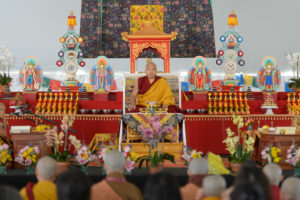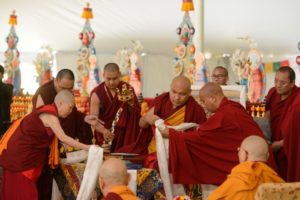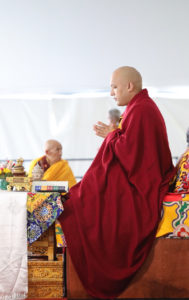Compassion for Oneself and for Others
North American Kagyu Monlam at York College, Queens, New York
June 6, 2018
His Holiness began his teachings, saying, “This is the first day of our gathering in New York City to celebrate the Ninth North American Kagyu Monlam. I would like to start by welcoming everyone who has come here, the lamas, male and female monastics, and male and female lay people as well.
“The celebration of the Kagyu Monlam in India was started by the previous Kalu Rinpoche and the previous Bokar Rinpoche. In 2000 I arrived in India, and afterward, began to convene it myself. At first it was called the Kamtsang Monlam, and we changed it to Kagyu Monlam to make it more embracing and non-sectarian. We also included in the practices, liturgical texts that come from many different traditions, as well as the words of the Buddha and other Indian sources.
“In the case of the present Kagyu Monlam, my intention was that Gyaltsap Rinpoche come to preside here, but he could not travel at this time. I asked him to bestow the teachings because he possesses all the attributes of a fully authentic Dharma master. Since he cannot come, I have no choice but to teach.
“We have three days of teaching scheduled on the Three Principal Aspects of the Path by the Lord Tsongkhapa. There are several commentaries on this text, but given the limited time we have, I will explain it based on the root text itself. The basis for my explanation is that I have received commentary on this text several times from His Holiness the Dalai Lama and also received a reading transmission in the context of the Treasury of Instructions with a commentary composed by Jamgön Kongtrul Lodrö Thaye.
“The text begins with the opening line of homage: I pay homage to the noble lord gurus, and continues:
The essential meaning of all the supreme speech of the Buddha,
Of the path that is praised by all holy bodhisattvas, and
Of the entrance for the fortunate, who seek liberation,
I will explain in the best way I can.
“The text can be divided into three parts: the introduction, the main body, and the conclusion. The first section is the introduction, which begins with the homage. In the opening line, the term “noble lord” does not need explanation. About the “guru” we can say that Je Tsongkhapa is prostrating to all gurus, especially to Manjushri. We might wonder why he is paying homage only to the gurus. It is to remind us that the guru, the spiritual friend, is the root of all goodness.
“The first four-line stanza above has been explained in a few ways. One of them relates the first three lines to the three topics or principles of the text: the first line is a summary of the first topic, the desire for freedom from samsara; the second line encapsulates the second topic, bodhichitta, and the third line refers to the third topic, the correct view of emptiness. One could also argue that each line refers to all three topics, but I think it is best to analyze this stanza in the first way with one line for each topic.
“The next verse reads:
Whoever is not attached to the pleasures of existence
And diligent in making their freedom and resources meaningful,
Is relying on the path that is pleasing to the buddhas.
Such fortunate ones listen with minds filled with faith.
This is followed by:
Without a completely pure desire for freedom from samsara,
There is no way to pacify suffering while one is seeking the result of pleasure
in the ocean of existence.
Through craving for further existence beings are utterly bound.
Therefore, first seek to develop a sincere desire for freedom from samsara.
“This section is concerned with the first of the three topics or principals, the desire for freedom. Here, Je Tsongkhapa presents three topics: the reason why it is necessary to develop this desire for freedom from samsara, how to do it, and the measure of an authentic one. Although there are many aspects of the Dharma to be practiced by an individual seeking liberation, in reducing them to their essence, the desire for liberation must come first. And this is not just the desire to be liberated from the three lower realms, but from all of samsara.
“This desire implies that we have the genuine and sincere wish to practice Dharma. Just thinking, “I’m practicing mahayana teachings,” does not suffice. For the Dharma to have an effect, we need the stable intention in our being to be free of samsara. This is the skillful means for becoming liberated. It is easy to repeat the words of wishing to be free of samsara, but not easy to know deeply that samsara has the very nature of suffering, and then based on this, give rise to the state of mind that naturally wishes to be freed of samsara. This genuine renunciation does not appear just like that. We must study and train so that we understand the nature of the three types of suffering and also how they appear in our lives.
“The three trainings taught by the Buddha begin with the first one, moral discipline. Those wising to attain liberation must have the motivation of engaging in moral discipline so they can achieve liberation. This is the goal on which they focus. If this is not the case and they have the worldly aim of finding mundane happiness or fame, or wealth, possessions and plentiful resources, they have missed the goal of liberation. Actually, whether the desire for freedom has entered our being or not depends on whether our practice is embraced by the genuine desire to attain liberation.
“There is a story that illustrates this point. A disciple once asked their lama about the practice of Kunrik (Sarvavid), a tantra for the purification of rebirth in lower states. “Does this practice belong to the Dharma of the Great Vehicle (mahayana) or the Dharma of the Foundational Vehicle (hinayana)?” the disciple questioned. Having done a good bit of practice, the lama looked inward and said, “If you are a true practitioner of mahayana Dharma, it is mahayana. If you are true practitioner of hinayana Dharma, it is hinayana. As for the way you and I practice, it is neither.”
“The great founder of the Drukpa Kagyu, the Lord Tsangpa Gyare (1161-1211), observed, ‘These days, people like high-flown Dharma and impressive terms that refer to great this and that—the Great Seal, the Great Perfection, the Great Middle Way, and so forth. Through these terms, people cling to these views and practices as some sort of solid thing. However, the teaching of the Great Perfection does not help if the person is not fully imbued in the Great Perfection. Sometimes there is gap between where the Dharma is and where people find themselves. This empty interval prevents them from blending the Dharma with their minds.
“There is a lot to learn from these stories. We think we are practicing the vajrayana, but we need to question that: Are we really practicing the vajrayana? We should look into our own minds, checking to see if we really have an altruistic motivation or not. We may have studied the mahayana and often recited, even memorized, the words of the mahayana, such as the Way of a Bodhisattva. However, to know if we are really practicing it or not, we have to look into the mirror of our minds. What do we see? Do we really have compassion and the wish to help all living beings? How far does our compassion go? All puffed up, we say, “Yes, of course, I’m practicing the mahayana.” Or “I’m engaged in vajrayana practice.” But are we really? We need to clarify this, checking our minds and correcting them.
“One way of looking at this is that the only difference between the desire for freedom from samsara and compassion is that the first is focused inwardly on compassion for oneself and the second is focused outwardly on compassion for all living beings. This means that in essence these two focuses come down to the same thing. The desire for freedom from samsara is compassion for oneself; compassion for others is the wish to free all of them from samsara. If the desire for freedom and compassion are the same thing, then without a sincere and stable desire for freedom from samsara for ourselves, it would be very difficult to have authentic compassion. If we do not care for ourselves, how could we care for others? Further, without authentic compassion, bodhichitta cannot appear. Finally, this entire process has to be based on a stable foundation.” Having arrived at bodhichitta, His Holiness concluded his teachings for the day.



